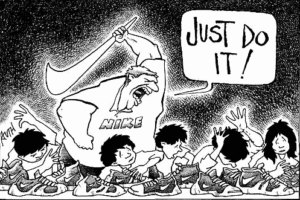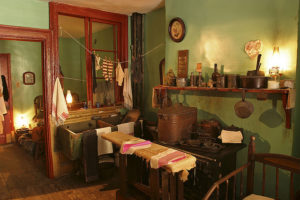Sweatshop Experiences
Sweatshops are referred to as a place of work, typically a factory or clothing production company, that abuses their workers by placing them in inhuman working conditions for very long hours with very little pay. While sweatshops were typically more common in less developed countries many years ago, suspicion has led to the investigation of big companies today, such as Nike, for making their factories into sweatshops. Being that Nike operates their production in about 41 countries, some being less developed countries such as Bangladesh and Cambodia, Nike has been accused of operating sweatshops in these smaller regions. Research from

WHO shows that Nike workers in Cambodia, since the year 2000, have complained of working in small buildings in which temperatures went as high as 37 degrees Celsius (98.6 degrees Fahrenheit) and earned wages of approximately fourteen cents and hour. While Nike has covered its tracks in recent years and have begun to include sustainability and women’s/LBGTQ+/minority group empowerment in their campaigns, it is unsure if the working conditions have entirely approved as Nike claims that they are not all responsible because those factories are subcontracted.
Sweatshops have been historically shown to provide employment for foreign immigrants and individuals expected not to work, such as women. In the years 1880-1940, the United States population grew by approximately 26 million people through immigration according to Smithsonian records. Being that so many immigrants traveled to the United Sates to start a new life with new opportunities, it was often hard to find employment. Sweatshops would become rather popular in the US at this time as they allowed a countless number of employees as the work environment was often overcrowded and it was cheap labor. Often, sweatshops were located in larger factory buildings to ensure the most amount of labor could be fit and used, however, sweatshops were also found in many tenement apartments.

Tenement apartments were typically three room apartments that would house families with any number of members; in this time period, families sizes were around five to nine members. The first room would be a bedroom in which the bed took up predominantly the entire room; some families would fit a much smaller futon-like piece of furniture in this room to maximize sleeping space. The second room in the apartment also contained at least one other bed while the rest of the space was the kitchen. Most apartments contained a stove and sink area although running water was not always running throughout the building, rather it was just outside and families would fill buckets up and bring them to their rooms. The third room was the sweatshop/factory space. This room, unless your family worked in a factory located outside of your home, would consist of sewing machines and fabrics as the father, possibly other families members, and outside workers would work long days constructing clothing. Many workers would fit in the rather tight space to complete their work tasks and pay levels were never that high.
Sweatshops were very commonly linked to immigration as they were the easiest form of employment to obtain and their were always open positions. While conditions were not always the best, immigrants would take these jobs because it was better than being unemployed and gave them a chance to provide income to the family. Containing a factory setup in a tenement apartment also allowed families to work longer hours and be in the environment of their own home and family. Sweatshops were very common at this time, however, they quickly grew out of business once labor laws begun to be implemented and workers were provided better working conditions.